Australian non-residential architectural styles
Australian non-residential architectural styles are a set of Australian architectural styles that apply to buildings used for purposes other than residence and have been around only since the first colonial government buildings of early European settlement of Australia in 1788.
Their distribution follows closely the establishment and growth of the different colonies of Australia, in that the earliest colonial buildings can be found in New South Wales and Tasmania.
The classifications set out below are derived from a leading Australian text.[1]
Old Colonial Period (1788–c. 1840)
- Old Colonial Georgian; Old Colonial Regency; Old Colonial Grecian; Old Colonial Gothic Picturesque
Georgian
 Hyde Park Barracks, Sydney; completed in 1819
Hyde Park Barracks, Sydney; completed in 1819.jpg.webp) St James' Church, Sydney; completed 1824
St James' Church, Sydney; completed 1824 St Matthew's Anglican Church, Windsor, New South Wales. Completed 1820
St Matthew's Anglican Church, Windsor, New South Wales. Completed 1820 Greenway Wing (Former Supreme Court of New South Wales) Sydney; completed 1828
Greenway Wing (Former Supreme Court of New South Wales) Sydney; completed 1828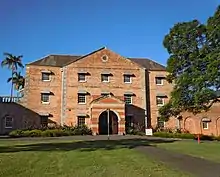 Female Orphan School; Parramatta, New South Wales. Completed 1818
Female Orphan School; Parramatta, New South Wales. Completed 1818 Old Liverpool Hospital (main block). 1822
Old Liverpool Hospital (main block). 1822 Shipwrights Arms Inn, Millers Point, Sydney. Completed 1834
Shipwrights Arms Inn, Millers Point, Sydney. Completed 1834 St Thomas Anglican Church, Port Macquarie, New South Wales. 1827
St Thomas Anglican Church, Port Macquarie, New South Wales. 1827.jpg.webp) St Luke's Anglican Church, Liverpool, New South Wales. Completed 1820
St Luke's Anglican Church, Liverpool, New South Wales. Completed 1820St_Peters_Anglican_Church_Campbelltown.jpg.webp) St Peter's Anglican Church, Campbelltown, New South Wales; completed 1820s
St Peter's Anglican Church, Campbelltown, New South Wales; completed 1820s The Old Windmill, Brisbane; completed 1824; Brisbane's oldest building
The Old Windmill, Brisbane; completed 1824; Brisbane's oldest building The Grange, Campbell Town, Tasmania; completed 1847
The Grange, Campbell Town, Tasmania; completed 1847
Regency
 St James Old Cathedral. King Street, Melbourne; 1839-1849, resited 1914. One of Melbourne's oldest surviving buildings
St James Old Cathedral. King Street, Melbourne; 1839-1849, resited 1914. One of Melbourne's oldest surviving buildings.jpg.webp) Old King's School, Parramatta, New South Wales. Completed 1833
Old King's School, Parramatta, New South Wales. Completed 1833 Lord Nelson Hotel, Millers Point, Sydney. Completed 1835
Lord Nelson Hotel, Millers Point, Sydney. Completed 1835 Sydney Mint. Sydney. Completed 1816. The oldest public building in Australia.
Sydney Mint. Sydney. Completed 1816. The oldest public building in Australia. Parliament House, Sydney. Completed 1816
Parliament House, Sydney. Completed 1816.jpg.webp) Hero of Waterloo Hotel, Sydney. Completed 1844
Hero of Waterloo Hotel, Sydney. Completed 1844.jpg.webp) Orient Hotel, The Rocks, New South Wales
Orient Hotel, The Rocks, New South Wales
Grecian
 The former Berrima court house, New South Wales. Completed in 1838
The former Berrima court house, New South Wales. Completed in 1838 Darlinghurst Courthouse, Darlinghurst, Sydney. Completed 1844
Darlinghurst Courthouse, Darlinghurst, Sydney. Completed 1844 St John's Anglican Church, Cooks Hill, Newcastle, New South Wales. Completed in 1860
St John's Anglican Church, Cooks Hill, Newcastle, New South Wales. Completed in 1860
Gothic Picturesque
.jpg.webp) The former government stables, now the Sydney Conservatorium of Music; completed in 1821, and a castellated example of the style
The former government stables, now the Sydney Conservatorium of Music; completed in 1821, and a castellated example of the style St James' Anglican Church, Morpeth, New South Wales; completed in 1840
St James' Anglican Church, Morpeth, New South Wales; completed in 1840_St_Patricks_Church_1.JPG.webp) St Patrick's Church, The Rocks, New South Wales; completed 1840
St Patrick's Church, The Rocks, New South Wales; completed 1840 Christ Church St Laurence Haymarket, Sydney. Completed 1845
Christ Church St Laurence Haymarket, Sydney. Completed 1845.jpg.webp) Holy Trinity Anglican Church (The Garrison Church), Millers Point, New South Wales; completed in 1846
Holy Trinity Anglican Church (The Garrison Church), Millers Point, New South Wales; completed in 1846
Victorian period (c. 1840–c. 1890)
The Victorian period, generally aligned with the reign of Queen Victoria, covers the period from c. 1840 to c. 1890 and comprises fifteen styles, all prefaced by the word "Victorian", and are namely, in loose chronological order, Georgian, Regency, Egyptian, Academic Classical, Free Classical, Filigree, Mannerist, Second Empire, Italianate, Romanesque, Byzantine, Academic Gothic, Free Gothic, Tudor, Rustic Gothic, and Carpenter Gothic.
Victorian Georgian
 Albury Court House, Albury, New South Wales; built 1860; Palladian-style
Albury Court House, Albury, New South Wales; built 1860; Palladian-style_(5045301b1).jpg.webp) Campbelltown Post Office, New South Wales
Campbelltown Post Office, New South Wales Campbell's Stores, The Rocks; built 1850–1861
Campbell's Stores, The Rocks; built 1850–1861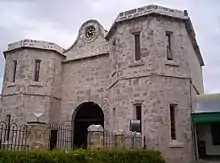 Fremantle Prison, Western Australia; built 1850–57
Fremantle Prison, Western Australia; built 1850–57
Victorian Regency
 Old Government House, Brisbane, Queensland; completed 1862
Old Government House, Brisbane, Queensland; completed 1862Sydney_School_of_Arts_Pitt_Street.jpg.webp) Sydney School of Arts, 1861
Sydney School of Arts, 1861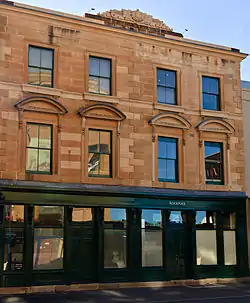 Rockpool, The Rocks, Sydney
Rockpool, The Rocks, Sydney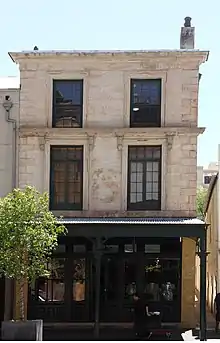 103 George Street, The Rocks, New South Wales
103 George Street, The Rocks, New South Wales Dundee Arms Hotel, The Rocks, Sydney
Dundee Arms Hotel, The Rocks, Sydney Redfern Town Hall, New South Wales
Redfern Town Hall, New South Wales
Victorian Egyptian
 Hobart Synagogue, Tasmania (1845)
Hobart Synagogue, Tasmania (1845) Commonwealth Bank building, Murwillumbah, New South Wales
Commonwealth Bank building, Murwillumbah, New South Wales Launceston Synagogue, Tasmania. (1846)
Launceston Synagogue, Tasmania. (1846)_(31621806573).jpg.webp) Masonic Centre, Adelaide, South Australia. (1858)
Masonic Centre, Adelaide, South Australia. (1858)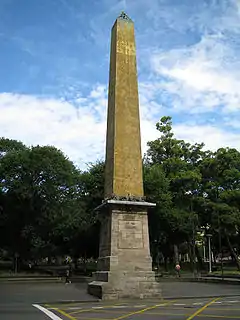 Obelisk at junction of Elizabeth and Bathurst Streets, Sydney
Obelisk at junction of Elizabeth and Bathurst Streets, Sydney Obelisk, Sydney, detail
Obelisk, Sydney, detail
Victorian Academic Classical
 Parliament House, Adelaide, South Australia; completed in 1889
Parliament House, Adelaide, South Australia; completed in 1889 Old State Library Building, Brisbane; completed 1879
Old State Library Building, Brisbane; completed 1879 State Library of Victoria, Swanston Street, Melbourne, Victoria; completed 1856
State Library of Victoria, Swanston Street, Melbourne, Victoria; completed 1856 Parliament House, Melbourne; completed 1856
Parliament House, Melbourne; completed 1856 Melbourne Trades Hall; completed 1875
Melbourne Trades Hall; completed 1875 Supreme Court of Victoria, Lonsdale Street, Melbourne; completed 1884
Supreme Court of Victoria, Lonsdale Street, Melbourne; completed 1884 St Kilda Town Hall, Victoria; completed 1890
St Kilda Town Hall, Victoria; completed 1890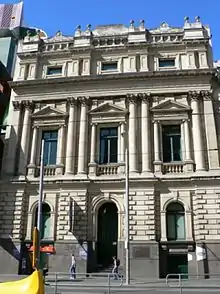 Former Hibernian Hall, Melbourne; completed 1887
Former Hibernian Hall, Melbourne; completed 1887 Former Baptist Church House, East Melbourne, Victoria; completed 1863
Former Baptist Church House, East Melbourne, Victoria; completed 1863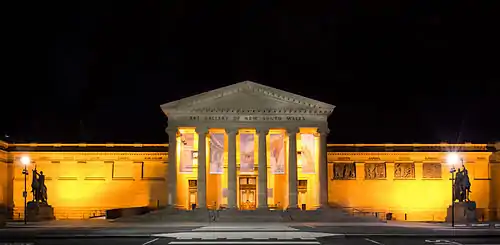 Art Gallery of New South Wales; completed 1890s
Art Gallery of New South Wales; completed 1890s.jpg.webp) Treasury Building, Sydney. Completed 1851
Treasury Building, Sydney. Completed 1851 Customs House, Sydney; completed in 1887
Customs House, Sydney; completed in 1887
 Australian Museum, Sydney; completed in 1857
Australian Museum, Sydney; completed in 1857 NSW Club House building; Sydney. Completed 1884
NSW Club House building; Sydney. Completed 1884_Bathurst_NSW.jpg.webp) Carrington House; Bathurst, New South Wales. Completed 1890
Carrington House; Bathurst, New South Wales. Completed 1890
Victorian Free Classical
 North Sydney Post Office, New South Wales; built between 1885-89[2]
North Sydney Post Office, New South Wales; built between 1885-89[2] General Post Office, Sydney; built between 1866-91 and 1910 in the Free Classical and Italian Renaissance styles[3][4]
General Post Office, Sydney; built between 1866-91 and 1910 in the Free Classical and Italian Renaissance styles[3][4] Goulburn Court House; built between 1885-87 and demonstrating Palladian concepts and Mannerist influences[5]
Goulburn Court House; built between 1885-87 and demonstrating Palladian concepts and Mannerist influences[5] Gardiner House, Sydney. 1885
Gardiner House, Sydney. 1885 Paddington Town Hall, Paddington, Sydney; built between 1890-91[6]
Paddington Town Hall, Paddington, Sydney; built between 1890-91[6]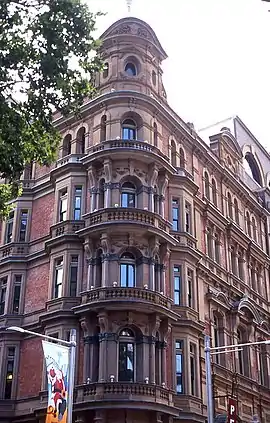 Hong Kong House, Sydney central business district[7]
Hong Kong House, Sydney central business district[7]Trades_Hall_Sydney-1.jpg.webp) Sydney Trades Hall, Sydney central business district; built between 1888–1916[8]
Sydney Trades Hall, Sydney central business district; built between 1888–1916[8] Albury Post Office, Albury, New South Wales. Completed 1880
Albury Post Office, Albury, New South Wales. Completed 1880 Bathurst Courthouse, New South Wales. Completed 1880
Bathurst Courthouse, New South Wales. Completed 1880 Grahame's Corner, Sydney. Completed 1882
Grahame's Corner, Sydney. Completed 1882 Orange Post Office, New South Wales. Completed 1879
Orange Post Office, New South Wales. Completed 1879 Pinnacle House, Sydney. Completed 1892
Pinnacle House, Sydney. Completed 1892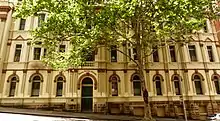 Royal Naval House, Sydney. Completed 1890s
Royal Naval House, Sydney. Completed 1890s Victoria Hotel in Albert Park, Victoria; completed 1888
Victoria Hotel in Albert Park, Victoria; completed 1888 Ballarat railway station, Ballarat, Victoria; completed in 1888[9]
Ballarat railway station, Ballarat, Victoria; completed in 1888[9] Customs House, Brisbane, Queensland; built between 1886-89[10]
Customs House, Brisbane, Queensland; built between 1886-89[10] Fitzroy Town Hall, Victoria; completed in 1890[11]
Fitzroy Town Hall, Victoria; completed in 1890[11] Fremantle Town Hall, Western Australia; built between 1885-87[12]
Fremantle Town Hall, Western Australia; built between 1885-87[12] National Hotel, Fremantle, Western Australia; built in the late 1800s
National Hotel, Fremantle, Western Australia; built in the late 1800s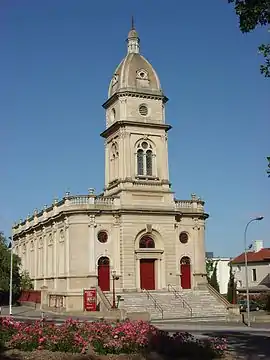 North Adelaide Congregational Church; built between in 1860-72[13]
North Adelaide Congregational Church; built between in 1860-72[13] Werribee Park Mansion in Werribee, Victoria; completed in 1877
Werribee Park Mansion in Werribee, Victoria; completed in 1877
Victorian Filigree
 The Regatta Hotel in Toowong, Queensland, present building constructed in 1886
The Regatta Hotel in Toowong, Queensland, present building constructed in 1886 Reid's Coffee Palace, Ballarat, Victoria; completed 1886
Reid's Coffee Palace, Ballarat, Victoria; completed 1886 The Sir William Wallace Hotel in Balmain, New South Wales; completed 1879
The Sir William Wallace Hotel in Balmain, New South Wales; completed 1879
Victorian Mannerist
Notable examples in Australia include: Culwulla Chambers (Sydney); Old Police Station, The Rocks Block Arcade (Melbourne); Stalbridge Chambers (Melbourne), National Bank Pall Mall (Bendigo); RESI Chambers (Melbourne); Lygon Buildings, Medley Hall (Carlton, Victoria); Former Money Order Post Office and Savings Bank (Melbourne); Mutual Store (Melbourne);
 Former Mutual Store, Flinders Street, Melbourne; completed 1891
Former Mutual Store, Flinders Street, Melbourne; completed 1891 Stalbridge Chambers, Little Collins Street, Melbourne; completed 1891
Stalbridge Chambers, Little Collins Street, Melbourne; completed 1891 Benvenuta, Carlton, Victoria; completed 1893
Benvenuta, Carlton, Victoria; completed 1893 Former Prahran Arcade, Prahran, Victoria; completed 1889
Former Prahran Arcade, Prahran, Victoria; completed 1889 Lygon Buildings, Lygon Street, Carlton, Victoria; completed 1888
Lygon Buildings, Lygon Street, Carlton, Victoria; completed 1888 The Strand Arcade, Sydney; Completed in 1892
The Strand Arcade, Sydney; Completed in 1892 Culwulla Chambers, Sydney; completed in 1912
Culwulla Chambers, Sydney; completed in 1912 The Sydney Club, Sydney. Completed 1887
The Sydney Club, Sydney. Completed 1887 73 York Street, Sydney (right hand side). Completed 1890s
73 York Street, Sydney (right hand side). Completed 1890s Agincourt Hotel; Chippendale, Sydney. Completed 1898
Agincourt Hotel; Chippendale, Sydney. Completed 1898 Cooma courthouse; Cooma, New South Wales
Cooma courthouse; Cooma, New South Wales
Victorian Second Empire
Notable examples include: Sydney Town Hall (Sydney); Hotel Windsor (Melbourne); Princess Theatre (Melbourne); Former Records Office (Melbourne); Melbourne General Post Office (Melbourne); Melbourne Town Hall (Melbourne); East Melbourne Synagogue (East Melbourne, Victoria); Royal Exhibition Building (Carlton, Victoria); Collingwood Town Hall (Collingwood, Victoria); South Melbourne Town Hall (South Melbourne, Victoria); Malvern Town Hall (Malvern, Victoria); Former Rechabite Hall (Prahran, Victoria); Brunswick Town Hall (Brunswick, Victoria); Camberwell Town Hall (Camberwell, Victoria); Bendigo Town Hall (Bendigo, Victoria); Shamrock Hotel (Bendigo Victoria); Bendigo Courthouse (Bendigo, Victoria); Bendigo Post Office (Bendigo, Victoria); Institute of Technology (Bendigo, Victoria); Queensland Parliament House (Brisbane)
 Princess Theatre, Melbourne, Victoria; completed 1866
Princess Theatre, Melbourne, Victoria; completed 1866 Queensland Parliament, Brisbane; completed 1868
Queensland Parliament, Brisbane; completed 1868 Kew Asylum, Kew, Victoria; completed 1871
Kew Asylum, Kew, Victoria; completed 1871 East Melbourne Synagogue. East Melbourne, Victoria; completed 1877
East Melbourne Synagogue. East Melbourne, Victoria; completed 1877 Royal Exhibition Building, Melbourne; completed 1880
Royal Exhibition Building, Melbourne; completed 1880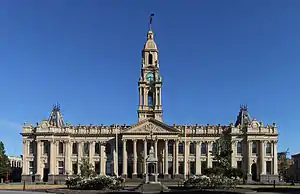 South Melbourne Town Hall, South Melbourne, Victoria; completed 1880
South Melbourne Town Hall, South Melbourne, Victoria; completed 1880 Hotel Windsor, Melbourne, Victoria; completed 1883
Hotel Windsor, Melbourne, Victoria; completed 1883 General Post Office; completed 18
General Post Office; completed 18 Former Rechabite Hall, Prahran, Victoria; completed 1888
Former Rechabite Hall, Prahran, Victoria; completed 1888 Malvern Town Hall, Malvern, Victoria; completed 1890
Malvern Town Hall, Malvern, Victoria; completed 1890 Bendigo Post Office, Bendigo, Victoria; completed 1892
Bendigo Post Office, Bendigo, Victoria; completed 1892 Bendigo Court House, Bendigo, Victoria; completed 1892
Bendigo Court House, Bendigo, Victoria; completed 1892 Shamrock Hotel, Bendigo, Victoria; completed 1897
Shamrock Hotel, Bendigo, Victoria; completed 1897 Grand Hotel, Healesville, Victoria
Grand Hotel, Healesville, Victoria.jpg.webp) Sydney Town Hall. Completed 1889
Sydney Town Hall. Completed 1889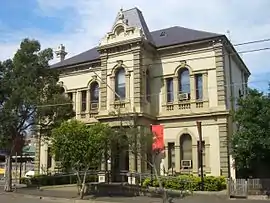 Waterloo Town Hall, Waterloo, New South Wales, with Victorian Italianate and Victorian Second Empire architectural elements. Completed 1881
Waterloo Town Hall, Waterloo, New South Wales, with Victorian Italianate and Victorian Second Empire architectural elements. Completed 1881 Chief Secretary's building, Sydney. Completed 1886. Also displays Victorian Free Classical architectural traits
Chief Secretary's building, Sydney. Completed 1886. Also displays Victorian Free Classical architectural traits.jpg.webp) City Bank building, Young, New South Wales.
City Bank building, Young, New South Wales. Bathurst District Hospital, Bathurst, New South Wales. Completed 1886
Bathurst District Hospital, Bathurst, New South Wales. Completed 1886 Tenterfield Post Office, New South Wales with Victorian Second Empire and Victorian Italianate architectural elements. Completed 1880s
Tenterfield Post Office, New South Wales with Victorian Second Empire and Victorian Italianate architectural elements. Completed 1880s
Victorian Italianate
 Albury railway station, Albury, New South Wales; built 1881
Albury railway station, Albury, New South Wales; built 1881 Institute Building, Darlington, Sydney
Institute Building, Darlington, Sydney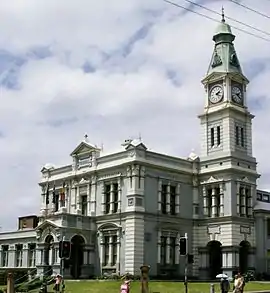 Leichhardt Town Hall, New South Wales; completed in 1888
Leichhardt Town Hall, New South Wales; completed in 1888 Balmain Court House, Balmain, Sydney. Completed 1888
Balmain Court House, Balmain, Sydney. Completed 1888Glebe_Town_Hall-2.jpg.webp) Glebe Town Hall, Glebe, New South Wales; built between 1879-80[14]
Glebe Town Hall, Glebe, New South Wales; built between 1879-80[14] Kings Hotel, Sydney. Completed 1879
Kings Hotel, Sydney. Completed 1879Hotel_CBD_006.jpg.webp) Former National House (now Hotel CBD), York Street, Sydney
Former National House (now Hotel CBD), York Street, Sydney Redfern Post Office, Sydney. Completed 1882
Redfern Post Office, Sydney. Completed 1882 Goulburn Post Office, New South Wales. Completed 1881
Goulburn Post Office, New South Wales. Completed 1881.jpg.webp) Forbes Post Office, New South Wales. Completed 1881
Forbes Post Office, New South Wales. Completed 1881 Royal Hotel, Queenscliff, Victoria
Royal Hotel, Queenscliff, Victoria Grand Hotel, Yarra Glen, Victoria
Grand Hotel, Yarra Glen, Victoria
Victorian Romanesque
.jpg.webp) St Michael's Uniting Church, Melbourne; completed 1866
St Michael's Uniting Church, Melbourne; completed 1866 Burns Philp Building, Sydney; completed 1901
Burns Philp Building, Sydney; completed 1901 St Mark's Church, Darling Point, New South Wales
St Mark's Church, Darling Point, New South Wales.jpg.webp) St Saviours Anglican Church, Redfern, New South Wales
St Saviours Anglican Church, Redfern, New South WalesSt_Johns_Church_Glebe_003a.jpg.webp) St Johns Church in Glebe, New South Wales; completed 1870
St Johns Church in Glebe, New South Wales; completed 1870 St Andrew's Church, Manly, New South Wales; completed in 1890[15]
St Andrew's Church, Manly, New South Wales; completed in 1890[15]
Victorian Renaissance Revival
_Dept_of_Lands_4.JPG.webp)
Bank_of_NSW_George_Street_Sydney-1.jpg.webp) Former Bank of NSW building, now KFC fast food restaurant, located at 107-109 Bathurst Street, Sydney, constructed between 1894 and 1895.[17]
Former Bank of NSW building, now KFC fast food restaurant, located at 107-109 Bathurst Street, Sydney, constructed between 1894 and 1895.[17] Newcastle Customs House, New South Wales. Completed 1899
Newcastle Customs House, New South Wales. Completed 1899
Victorian Byzantine
 Jubilee Building, Perth; opened 1899
Jubilee Building, Perth; opened 1899Surry_Hills_Orthodox_Church.jpg.webp) Holy Trinitity Orthodox Church; Surry Hills, Sydney. Completed 1890s
Holy Trinitity Orthodox Church; Surry Hills, Sydney. Completed 1890s
Victorian Academic Gothic
 St Paul's Cathedral, Melbourne
St Paul's Cathedral, Melbourne.jpg.webp)
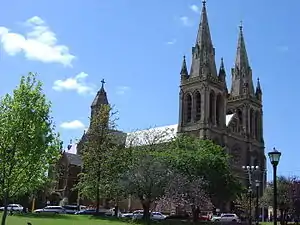 St Peter's Cathedral, Adelaide; completed 1901
St Peter's Cathedral, Adelaide; completed 1901%252C_View_from_Sydney_Tower%252C_St_Mary's_Cathedral_--_2019_--_3141.jpg.webp)
 St Andrew's Cathedral, Sydney. Completed 1868
St Andrew's Cathedral, Sydney. Completed 1868 University of Sydney (main quadrangle); completed 1855
University of Sydney (main quadrangle); completed 1855 Anderson Stuart Building (University of Sydney); completed 1883
Anderson Stuart Building (University of Sydney); completed 1883 Old Pathology Building (University of Melbourne); completed 1885
Old Pathology Building (University of Melbourne); completed 1885 St Peter's Cathedral, Armidale, New South Wales. Completed 1875
St Peter's Cathedral, Armidale, New South Wales. Completed 1875 St John's College, Sydney
St John's College, Sydney
Victorian Ecclesiastical Gothic
 St David's Uniting Church, Haberfield, Sydney; completed 1861 as a Presbyterian church
St David's Uniting Church, Haberfield, Sydney; completed 1861 as a Presbyterian church
Victorian Free Gothic
 Former Metropolitan Gas Company Buildings; Flinders Street, Melbourne; completed 1892; Venetian Gothic applied to a tall building
Former Metropolitan Gas Company Buildings; Flinders Street, Melbourne; completed 1892; Venetian Gothic applied to a tall building Ormond College, Melbourne University; completed 1881
Ormond College, Melbourne University; completed 1881 Former Stock Exchange, Collins Street, Melbourne; completed 1888
Former Stock Exchange, Collins Street, Melbourne; completed 1888 Former Safe Deposit Building, Collins Street, Melbourne; completed 1890
Former Safe Deposit Building, Collins Street, Melbourne; completed 1890 ANZ Bank, 390 Collins Street, Melbourne; completed 1883
ANZ Bank, 390 Collins Street, Melbourne; completed 1883 Old Rialto, Collins Street, Melbourne; completed 1888
Old Rialto, Collins Street, Melbourne; completed 1888 Olderfleet Buildings. Collins Street, Melbourne; completed 1888
Olderfleet Buildings. Collins Street, Melbourne; completed 1888 St George's Presbyterian Church, St Kilda East, Victoria; completed 1880
St George's Presbyterian Church, St Kilda East, Victoria; completed 1880 Victoria Brewery, East Melbourne, Victoria; completed 1882
Victoria Brewery, East Melbourne, Victoria; completed 1882.jpg.webp) The Great Synagogue, Sydney; completed 1878[18]
The Great Synagogue, Sydney; completed 1878[18] St Vincent's College, Potts Point, Sydney. Completed 1886
St Vincent's College, Potts Point, Sydney. Completed 1886.jpg.webp) St Patrick's Seminary, Manly, New South Wales; completed 1885
St Patrick's Seminary, Manly, New South Wales; completed 1885 Hunter Baillie Memorial Presbyterian Church, Annandale, New South Wales. Completed 1889
Hunter Baillie Memorial Presbyterian Church, Annandale, New South Wales. Completed 1889 St Paul's Presbyterian Church; Armidale, New South Wales. Completed 1882
St Paul's Presbyterian Church; Armidale, New South Wales. Completed 1882 Former Sussex Street Public School, Sydney. Completed 1876
Former Sussex Street Public School, Sydney. Completed 1876 Nightingale Wing, Sydney Hospital. Completed 1869
Nightingale Wing, Sydney Hospital. Completed 1869 Royal Prince Alfred Hospital, Camperdown, New South Wales. Completed 1892
Royal Prince Alfred Hospital, Camperdown, New South Wales. Completed 1892 Rozelle Public School, Rozelle, Sydney
Rozelle Public School, Rozelle, Sydney
Victorian Tudor (Jacobethan)
 Government House, Sydney with Gothic Picturesque elements. Completed 1845
Government House, Sydney with Gothic Picturesque elements. Completed 1845 Old Arts Building, University of Melbourne; completed 1857
Old Arts Building, University of Melbourne; completed 1857 Main Quadrangle, University of Sydney; completed 1862
Main Quadrangle, University of Sydney; completed 1862 Government House, Perth; completed in 1864
Government House, Perth; completed in 1864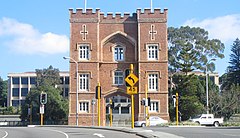 The Barracks Arch, Perth; completed in 1863
The Barracks Arch, Perth; completed in 1863 HM Prison Pentridge, Coburg, Victoria; completed in 1864
HM Prison Pentridge, Coburg, Victoria; completed in 1864 Old Registry Wing (Supreme Court of New South Wales), Sydney. Completed 1862
Old Registry Wing (Supreme Court of New South Wales), Sydney. Completed 1862 North Terrace, University of Adelaide
North Terrace, University of Adelaide
Victorian Rustic Gothic
St_Marks_Rectory.jpg.webp) St Mark's Rectory, Darling Point, Sydney
St Mark's Rectory, Darling Point, Sydney Tenterfield School of Arts, New South Wales.
Tenterfield School of Arts, New South Wales.Ryde_Public_School_Infants_Section.jpg.webp) Ryde Public School; Ryde, New South Wales
Ryde Public School; Ryde, New South WalesManly_Congregational_Church-2.jpg.webp) Manly Congregational Church, New South Wales
Manly Congregational Church, New South Wales_(5045453b1).jpg.webp) Former North Sydney Technical High School, North Sydney, New South Wales
Former North Sydney Technical High School, North Sydney, New South Wales
Victorian Carpenter Gothic
 Christ the King Church, Graceville, Queensland
Christ the King Church, Graceville, Queensland Blayney Uniting Church; Blayney, New South Wales.
Blayney Uniting Church; Blayney, New South Wales. St John's Lutheran Church, Minyip, Victoria
St John's Lutheran Church, Minyip, Victoria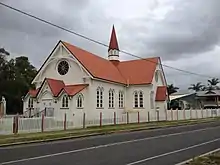 Sandgate Baptist Church, Queensland
Sandgate Baptist Church, Queensland
Edwardian period (c. 1890s–1910)
Edwardian architecture is generally less ornate than high or late Victorian architecture,[19] apart from a subset - used for major buildings - known as Edwardian Baroque architecture.
Edwardian Baroque
Notable examples include the Lands Administration Building in Brisbane, the Queen Victoria Hospital, Melbourne (main pavilion, now Queen Victoria Women's Centre), the Commonwealth Offices, Treasury Place, Melbourne, the Department of Education building in Sydney (1912)[20] and the General Post Office in Hobart.
 Department of Education building, Sydney.
Department of Education building, Sydney. Land Administration Building, Brisbane. Completed 1905
Land Administration Building, Brisbane. Completed 1905 Queen Victoria Hospital, Melbourne. Completed 1916
Queen Victoria Hospital, Melbourne. Completed 1916 General Post Office, Hobart. Completed 1905
General Post Office, Hobart. Completed 1905
Federation period (c. 1890–c. 1915)
12 styles, each style name prefaced by "Federation":
- Academic Classical, Free Classical, Filigree, Anglo-Dutch, Romanesque, Gothic, Carpenter Gothic, Warehouse, Queen Anne, Free Style, Arts and Crafts, Bungalow
Federation Academic Classical
 Mitchell Library, State Library of New South Wales, completed 1910
Mitchell Library, State Library of New South Wales, completed 1910 The Art Gallery of New South Wales, completed 1906
The Art Gallery of New South Wales, completed 1906 Newcastle Post Office, completed 1903
Newcastle Post Office, completed 1903
Federation Free Classical
Notable examples include: Sydney Hospital (Sydney), Taronga Zoo Pavilion (Sydney), the main terminus building of the Central railway station in Sydney,[21] Flinders Street station (Melbourne), Sacred Heart Church (St Kilda, Victoria), Read's Emporium (Prahran, Victoria), Old Royal Hotel (Williamstown, Victoria), the former Queensland Lands Administration Building (Brisbane).
 Flinders Street station, Melbourne, completed 1910
Flinders Street station, Melbourne, completed 1910 Former Read's Emporium, Prahran, completed 1914
Former Read's Emporium, Prahran, completed 1914 Old Royal Hotel, Williamstown, with arts and crafts influences
Old Royal Hotel, Williamstown, with arts and crafts influences Sacred Heart Church, St Kilda, completed 1891
Sacred Heart Church, St Kilda, completed 1891 Former Lands Administration Building, Brisbane, completed 1905
Former Lands Administration Building, Brisbane, completed 1905 Sydney Hospital, completed 1894
Sydney Hospital, completed 1894 Queen Victoria Hospital, completed 1912
Queen Victoria Hospital, completed 1912 Perth Institute of Contemporary Arts Building, completed 1896
Perth Institute of Contemporary Arts Building, completed 1896 Central railway station, Sydney. Completed 1906
Central railway station, Sydney. Completed 1906 Former Parcels Post Office, Railway Square, Sydney. Completed 1913
Former Parcels Post Office, Railway Square, Sydney. Completed 1913TAFE_building_Railway_Square.jpg.webp) Marcus Clarke Building (TAFE), Railway Square, Sydney. Completed 1910-1924
Marcus Clarke Building (TAFE), Railway Square, Sydney. Completed 1910-1924 Taronga Zoo Sydney. Completed 1916
Taronga Zoo Sydney. Completed 1916.jpg.webp) Thomas Walker Convalescent Hospital, Concord, New South Wales. Completed 1893
Thomas Walker Convalescent Hospital, Concord, New South Wales. Completed 1893
Federation Second Empire
 Former Records Office. Queen Street, Melbourne. Completed 1900.
Former Records Office. Queen Street, Melbourne. Completed 1900. Town Hall Administration Buildings. Swanston Street, Melbourne. Completed 1908.
Town Hall Administration Buildings. Swanston Street, Melbourne. Completed 1908.
Federation Filigree
 Exchange Hotel, Kalgoorlie, Western Australia. Completed 1900
Exchange Hotel, Kalgoorlie, Western Australia. Completed 1900 Freemasons Hotel, Fremantle, Western Australia
Freemasons Hotel, Fremantle, Western Australia Brass Monkey Hotel, Perth, Western Australia
Brass Monkey Hotel, Perth, Western Australia P&O Hotel, Fremantle, Western Australia. Completed 1901
P&O Hotel, Fremantle, Western Australia. Completed 1901 Palace Hotel, Childers, Queensland. Completed 1902
Palace Hotel, Childers, Queensland. Completed 1902 People's Palace, Brisbane, Queensland. Completed 1911
People's Palace, Brisbane, Queensland. Completed 1911
Federation Anglo-Dutch
 The ASN Co building, Sydney a very early and rare pre-Federation version of the style; completed in 1885
The ASN Co building, Sydney a very early and rare pre-Federation version of the style; completed in 1885 City of Melbourne buildings, Elizabeth Street, Melbourne, a very early example of the style; completed in 1888
City of Melbourne buildings, Elizabeth Street, Melbourne, a very early example of the style; completed in 1888 University of Melbourne main buildings, Carlton; completed in 1888
University of Melbourne main buildings, Carlton; completed in 1888 Prahran Market, Prahran; completed in 1891, early Anglo-Dutch
Prahran Market, Prahran; completed in 1891, early Anglo-Dutch St Nicholas Hospital buildings, Carlton
St Nicholas Hospital buildings, Carlton Eastern Hill Fire Station, East Melbourne; completed in 1893
Eastern Hill Fire Station, East Melbourne; completed in 1893 Winfield Building, Collins Street, Melbourne, also demonstrates Queen Anne traits; completed in 1891
Winfield Building, Collins Street, Melbourne, also demonstrates Queen Anne traits; completed in 1891 Perseverance Hotel, Fitzroy
Perseverance Hotel, FitzroyCorporation_Building_Sydney.jpg.webp) Corporation Building, Haymarket, Sydney. Completed 1893[22]
Corporation Building, Haymarket, Sydney. Completed 1893[22] Crown Hotel, Sydney. Completed 1909
Crown Hotel, Sydney. Completed 1909


 Chamberlain Hotel, Sydney. Completed 1904
Chamberlain Hotel, Sydney. Completed 1904 The Trocadero, Newtown, Sydney. Completed 1889[26]
The Trocadero, Newtown, Sydney. Completed 1889[26] York Hotel, Kalgoorlie, Western Australia. Completed 1901
York Hotel, Kalgoorlie, Western Australia. Completed 1901
Federation Romanesque
 Queen Victoria Building, Sydney; completed in 1898
Queen Victoria Building, Sydney; completed in 1898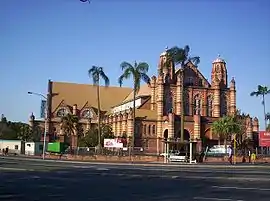
 Bairnsdale Court House, Bairnsdale; completed in 1893
Bairnsdale Court House, Bairnsdale; completed in 1893 Perth Mint, Perth, completed in 1899
Perth Mint, Perth, completed in 1899
 St Mary's Roman Catholic Church, Bairnsdale; completed in 1913
St Mary's Roman Catholic Church, Bairnsdale; completed in 1913 Our Lady of the Victories Basilica, Camberwell; completed in 1918
Our Lady of the Victories Basilica, Camberwell; completed in 1918 Hackett Hall, Perth; completed 1908, now part of the Western Australian Museum
Hackett Hall, Perth; completed 1908, now part of the Western Australian Museum 354 George Street (Former Bank of Australasia), Sydney, Completed 1904
354 George Street (Former Bank of Australasia), Sydney, Completed 1904350_George_Street-3.jpg.webp) Former Societe Generale Building, Sydney. Completed 1895
Former Societe Generale Building, Sydney. Completed 1895 Sydney Technical College (Former Sydney Technical High School building). Completed 1891
Sydney Technical College (Former Sydney Technical High School building). Completed 1891_Shelbourne_Hotel.JPG.webp) Shelbourne Hotel, Sydney. Completed 1902
Shelbourne Hotel, Sydney. Completed 1902
Federation Gothic
 A.C Goode House in Collins Street, Melbourne; completed in 1891
A.C Goode House in Collins Street, Melbourne; completed in 1891 Camperdown Memorial Clock Tower in Camperdown, Victoria; completed in 1897
Camperdown Memorial Clock Tower in Camperdown, Victoria; completed in 1897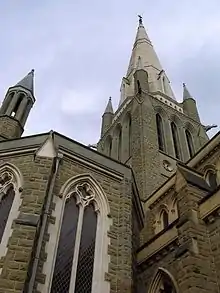 Sacred Heart Cathedral in Bendigo, Victoria; completed in 1896
Sacred Heart Cathedral in Bendigo, Victoria; completed in 1896.jpg.webp) RMIT Building 4, Swanston Street, Melbourne; completed in 1904
RMIT Building 4, Swanston Street, Melbourne; completed in 1904 Registrar-General's building, in Sydney; completed in 1913
Registrar-General's building, in Sydney; completed in 1913 MacLaurin Hall, University of Sydney. Completed 1902-1909
MacLaurin Hall, University of Sydney. Completed 1902-1909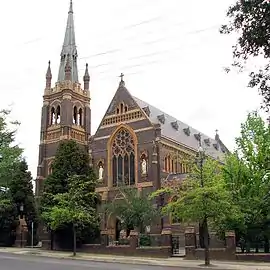 Saints Mary and Joseph Cathedral; Armidale, New South Wales. Completed 1912
Saints Mary and Joseph Cathedral; Armidale, New South Wales. Completed 1912
Federation Carpenter Gothic
 Coonamble Anglican Church, New South Wales
Coonamble Anglican Church, New South Wales St Mary's Church, Townsville, Queensland
St Mary's Church, Townsville, Queensland The Uniting Church, Penguin, Tasmania. Completed 1903
The Uniting Church, Penguin, Tasmania. Completed 1903 The Uniting Church at Narooma, New South Wales; completed in 1914
The Uniting Church at Narooma, New South Wales; completed in 1914
Federation Warehouse
 The Big Store. Prahran, Victoria; completed 1902, an early and exuberant example of the style
The Big Store. Prahran, Victoria; completed 1902, an early and exuberant example of the style
Federation Queen Anne
 The Austral Buildings, Collins Street, Melbourne; completed in 1891
The Austral Buildings, Collins Street, Melbourne; completed in 1891 Professional Chambers, Collins Street, Melbourne; completed in 1908
Professional Chambers, Collins Street, Melbourne; completed in 1908 The Sydney Corn Exchange, a rare remaining warehouse; built from 1887 and designed by George McRae[27]
The Sydney Corn Exchange, a rare remaining warehouse; built from 1887 and designed by George McRae[27] Grace Brothers Department Store, Broadway, Sydney. Completed 1923
Grace Brothers Department Store, Broadway, Sydney. Completed 1923St_Augustine_Church-4.jpg.webp) St Augustine's Church, Balmain, New South Wales. Completed 1905
St Augustine's Church, Balmain, New South Wales. Completed 1905
Federation Free Style
 Former Mechanics Institute, Prahran, Victoria
Former Mechanics Institute, Prahran, Victoria Provincial Hotel, Ballarat, Victoria; completed in 1909 A fanciful freestyle composition with art nouveau elements.
Provincial Hotel, Ballarat, Victoria; completed in 1909 A fanciful freestyle composition with art nouveau elements. Dimmey's, Cremorne, Victoria
Dimmey's, Cremorne, Victoria
 York Post Office, York, Western Australia
York Post Office, York, Western Australia Observer Hotel, The Rocks, Sydney. Completed 1908
Observer Hotel, The Rocks, Sydney. Completed 1908 Orchards Corner, Sydney
Orchards Corner, Sydney International House, Sydney
International House, Sydney Kings Cross Hotel, Sydney
Kings Cross Hotel, SydneyPyrmont_Fire_Station-2.jpg.webp) Pyrmont Fire Station, Sydney. Completed 1906
Pyrmont Fire Station, Sydney. Completed 1906
Federation Arts and Crafts
 Victorian Artists Society, Albert Street, East Melbourne, Victoria
Victorian Artists Society, Albert Street, East Melbourne, Victoria Glen Innes Post Office, New South Wales
Glen Innes Post Office, New South Wales Former Post & Telegraph Offices, Windsor, Victoria
Former Post & Telegraph Offices, Windsor, Victoria The Jenolan Caves House, New South Wales
The Jenolan Caves House, New South Wales
Inter-War period (c. 1915–'c. 1940)
16 styles, each style name prefaced by "Inter-War":
- Georgian Revival, Academic Classical, Free Classical, Beaux-Arts, Stripped Classical, Commercial Palazzo, Mediterranean, Spanish Mission, Chicagoesque, Functionalist & Modern, Art-Deco, Skyscraper Gothic, Romanesque, Interwar Gothic, Old English, California Bungalow
Inter-war Georgian Revival
 Albert Hall, Canberra, opened 1928
Albert Hall, Canberra, opened 1928 Elizabeth Murdoch Building, Victorian College of the Arts, Melbourne
Elizabeth Murdoch Building, Victorian College of the Arts, MelbourneManly_Municipal_Council.jpg.webp) Manly Town Hall, New South Wales
Manly Town Hall, New South Wales
Inter-war Academic Classical
 Brisbane City Hall; opened in 1930
Brisbane City Hall; opened in 1930 Shrine of Remembrance, Brisbane; completed in 1930
Shrine of Remembrance, Brisbane; completed in 1930 Shrine of Remembrance, Melbourne; completed in 1934
Shrine of Remembrance, Melbourne; completed in 1934
Inter-war Free Classical
 CML Building, Geelong; completed in 1923
CML Building, Geelong; completed in 1923Radisson_PLaza_Hotel-1.jpg.webp) Former Sydney Morning Herald building, Pitt Street, Sydney. Completed 1920s
Former Sydney Morning Herald building, Pitt Street, Sydney. Completed 1920s Publlic Trust Office, Sydney. Completed 1926
Publlic Trust Office, Sydney. Completed 1926
Inter-war Beaux Arts
 Former Melbourne Mail Exchange, Bourke Street, Melbourne; completed in 1917
Former Melbourne Mail Exchange, Bourke Street, Melbourne; completed in 1917 Former Port Authority Building, Market Street, Melbourne
Former Port Authority Building, Market Street, Melbourne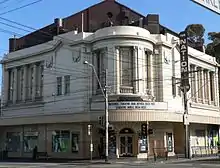 National Theatre. St Kilda, Victoria; completed 1920
National Theatre. St Kilda, Victoria; completed 1920 Herald and Weekly Times Building, Flinders Street, Melbourne
Herald and Weekly Times Building, Flinders Street, Melbourne Argus Building. LaTrobe Street, Melbourne; completed 1927. Features large giant order columns with Egyptian decorative motifs
Argus Building. LaTrobe Street, Melbourne; completed 1927. Features large giant order columns with Egyptian decorative motifs General Post Office, Perth, Western Australia; completed 1923
General Post Office, Perth, Western Australia; completed 1923 Commonwealth Bank building, Forrest Place, Perth, Western Australia; completed 1933
Commonwealth Bank building, Forrest Place, Perth, Western Australia; completed 1933Commonwealth_Bank_Sydney-1.jpg.webp) Commonwealth Bank building, Martin Place, Sydney. Completed 1928
Commonwealth Bank building, Martin Place, Sydney. Completed 1928Perpetual_Trustee_Company_Limited-2.jpg.webp) Perpetual Trustee building, Sydney. Completed 1917
Perpetual Trustee building, Sydney. Completed 1917Beaux_Arts_style_Sydney-2.jpg.webp) Beaux Arts Style office block, Sydney
Beaux Arts Style office block, Sydney1)Banking_House_Pitt_Street_Sydney.jpg.webp) Banking House, Sydney. Completed 1912
Banking House, Sydney. Completed 1912Beaux_Arts_building_Broadway_Sydney.jpg.webp) Beaux Arts style commercial building in Broadway, Sydney
Beaux Arts style commercial building in Broadway, Sydney
Inter-war Stripped Classical
 Old Parliament House, Canberra, designed by John Smith Murdoch; opened 1927
Old Parliament House, Canberra, designed by John Smith Murdoch; opened 1927 T&G building in Geelong, Victoria; opened 1933
T&G building in Geelong, Victoria; opened 1933 Wyvern House, Newington College; opened 1938
Wyvern House, Newington College; opened 1938 AMP building in Albury, New South Wales
AMP building in Albury, New South Wales Petersham Town Hall, New South Wales; designed in 1938
Petersham Town Hall, New South Wales; designed in 1938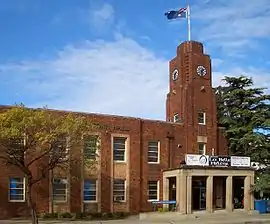 Rockdale Town Hall, New South Wales; designed in 1940
Rockdale Town Hall, New South Wales; designed in 1940
Inter-war Commercial Palazzo
 Westpac Bank building. 33 Queen Street, Brisbane; completed 1920
Westpac Bank building. 33 Queen Street, Brisbane; completed 1920 London Stores. Elizabeth Street, Melbourne; completed 1922
London Stores. Elizabeth Street, Melbourne; completed 1922 Temple Court. Collins Street, Melbourne; completed 1924
Temple Court. Collins Street, Melbourne; completed 1924 Nicholas Building. Swanston Street, Melbourne; completed 1925
Nicholas Building. Swanston Street, Melbourne; completed 1925 Former AMP Building. Collins Street, Melbourne; completed 1927
Former AMP Building. Collins Street, Melbourne; completed 1927 Myer Melbourne main store, Lonsdale Street, Melbourne; completed 1933
Myer Melbourne main store, Lonsdale Street, Melbourne; completed 1933 MacArthur Central. cnr Queen and Edward Streets, Brisbane; completed 1934
MacArthur Central. cnr Queen and Edward Streets, Brisbane; completed 1934 341 George Street, Sydney. Completed 1920s
341 George Street, Sydney. Completed 1920sCommercial_Banking_Company_George_Street.jpg.webp) Commercial Banking Company, George Street, Sydney. Completed 1920s
Commercial Banking Company, George Street, Sydney. Completed 1920s Trust Building; Sydney. Completed 1916
Trust Building; Sydney. Completed 1916.jpg.webp) Gowings Building, Sydney. Completed 1929
Gowings Building, Sydney. Completed 1929.jpg.webp) Commonwealth Trading Bank building, Sydney. Completed 1916
Commonwealth Trading Bank building, Sydney. Completed 1916
Inter-war Mediterranean
 Sydney and Melbourne buildings, City Centre, Australian Capital Territory; commenced building 1920s
Sydney and Melbourne buildings, City Centre, Australian Capital Territory; commenced building 1920s St Kilda Sea Baths. St Kilda, Victoria
St Kilda Sea Baths. St Kilda, Victoria
 Markets, West End, Queensland
Markets, West End, Queensland
Inter-war Art Deco
 Australian War Memorial; building completed 1941; Byzantine architecture style with strong styling elements of art deco throughout
Australian War Memorial; building completed 1941; Byzantine architecture style with strong styling elements of art deco throughout Palais Theatre, Melbourne; completed 1927; Strong Byzantine influences
Palais Theatre, Melbourne; completed 1927; Strong Byzantine influences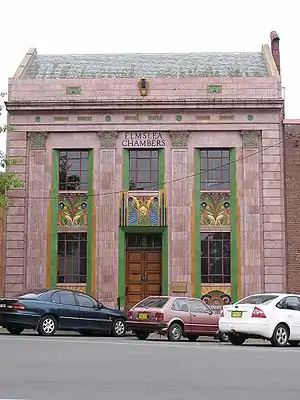 Elmslea Chambers, Goulburn, New South Wales; built 1933; it was one of the first buildings in Australia to use Glazed architectural terra-cotta in its façade
Elmslea Chambers, Goulburn, New South Wales; built 1933; it was one of the first buildings in Australia to use Glazed architectural terra-cotta in its façade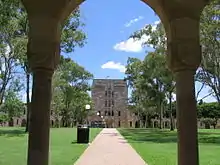 Forgan Smith Buildings and Great Court, University of Queensland; completed 1927
Forgan Smith Buildings and Great Court, University of Queensland; completed 1927 ANZAC War Memorial, Sydney; completed 1934.
ANZAC War Memorial, Sydney; completed 1934. Art Deco office building. Lonsdale Street, Melbourne. Obvious influences of North American skyscraper planning
Art Deco office building. Lonsdale Street, Melbourne. Obvious influences of North American skyscraper planning Alkira House, Queen Street, Melbourne. One of the most striking Glazed architectural terra-cotta and glass brick clad Art Deco buildings in Australia
Alkira House, Queen Street, Melbourne. One of the most striking Glazed architectural terra-cotta and glass brick clad Art Deco buildings in Australia Gledden Building, Perth; completed in 1935. The Gledden Building was the only large commercial building in the Art Deco style ever built in Western Australia
Gledden Building, Perth; completed in 1935. The Gledden Building was the only large commercial building in the Art Deco style ever built in Western Australia.jpg.webp)
 Museum of Contemporary Art, Sydney. Completed 1940s
Museum of Contemporary Art, Sydney. Completed 1940s APA Building Martin Place, Sydney
APA Building Martin Place, Sydney State Theatre (Sydney). Competed 1929
State Theatre (Sydney). Competed 1929
 City Mutual Life Assurance Building, Sydney. Completed 1936
City Mutual Life Assurance Building, Sydney. Completed 1936 Henry Davis York Building, Sydney.
Henry Davis York Building, Sydney._in_Sydney.jpg.webp) Railway House, York Street, Sydney
Railway House, York Street, Sydney.jpg.webp) Challis House, Martin Place, Sydney. Completed 1938
Challis House, Martin Place, Sydney. Completed 1938 David Jones Building, Elizabeth Street, Sydney
David Jones Building, Elizabeth Street, Sydney
Federation Skyscraper Gothic
 Victoria Hotel on Little Collins Street, Melbourne
Victoria Hotel on Little Collins Street, Melbourne.jpg.webp) Grace Building, Sydney
Grace Building, Sydney Manchester Unity Building. Collins Street, Melbourne
Manchester Unity Building. Collins Street, Melbourneformer_Sun_Building-2.jpg.webp) Former Sun building
Former Sun buildingformer_Sun_Building-1.jpg.webp) Former Sun building, Elizabeth Street, Sydney
Former Sun building, Elizabeth Street, Sydney
Inter-war Chicagoesque
 Capitol Theatre, Swanston Street, Melbourne; opened in 1924
Capitol Theatre, Swanston Street, Melbourne; opened in 1924 Former Masonic Club, Flinders Street, Melbourne
Former Masonic Club, Flinders Street, Melbourne
 Love and Lewis building. Prahran, Victoria; completed in 1928
Love and Lewis building. Prahran, Victoria; completed in 1928 Dovers Building, by Hugh Ralston Crawford; completed 1908
Dovers Building, by Hugh Ralston Crawford; completed 1908 Perth}}, Western Australia; completed 1927
Perth}}, Western Australia; completed 1927 Metropolitan Water Sewerage & Drainage Board Building Pitt Street, Sydney. 1939
Metropolitan Water Sewerage & Drainage Board Building Pitt Street, Sydney. 1939
Inter-war Functionalist & Moderne
 Lonsdale House, Lonsdale Street, Melbourne; architect IG Anderson; completed 1937; demolished 2010
Lonsdale House, Lonsdale Street, Melbourne; architect IG Anderson; completed 1937; demolished 2010 Presgrave Building, Little Collins Street, Melbourne; completed 1938
Presgrave Building, Little Collins Street, Melbourne; completed 1938 Former Victoria carpark, Little Collins Street, Melbourne; completed 1939; Melbourne's oldest multi-storey carpark in the streamline moderne style
Former Victoria carpark, Little Collins Street, Melbourne; completed 1939; Melbourne's oldest multi-storey carpark in the streamline moderne style Hastings Deering, Crown Street, Woolloomooloo, New South Wales; Architects Lipson & Kaad; completed 1938; refurbished 2013
Hastings Deering, Crown Street, Woolloomooloo, New South Wales; Architects Lipson & Kaad; completed 1938; refurbished 2013
Interwar Gothic
 Newman College, Melbourne; opened 1918
Newman College, Melbourne; opened 1918 Montsalvat artists colony (Great Hall), Eltham, Victoria; re-uses architectural elements from demolished Collins Street buildings; completed 1938
Montsalvat artists colony (Great Hall), Eltham, Victoria; re-uses architectural elements from demolished Collins Street buildings; completed 1938
Inter-war Old English (20th Century Tudorbethan)
 Shopfront in Toorak, Victoria
Shopfront in Toorak, Victoria A mock Tudor row on Commercial Road, South Yarra, Victoria
A mock Tudor row on Commercial Road, South Yarra, Victoria London Court shopping complex in Perth, Western Australia
London Court shopping complex in Perth, Western Australia
Federation Functionalist & Moderne
The functionalist and moderne style often used combinations of blonde and brown bricks in linear vertical or horizontal patterns. Notable examples include: Museum of Contemporary Art (Sydney); Captain's Flat Hotel (NSW); Russell Street Police Headquarters (Melbourne); Astor Theatre (St Kilda, Victoria); Ballarat Law Courts (Ballarat);
 Hotel at Captains Flat, New South Wales built 1938; Functionalist
Hotel at Captains Flat, New South Wales built 1938; Functionalist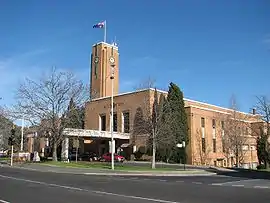 Heidelberg Town Hall, Heidelberg, Victoria; built 1937; a fine example of interwar brick moderne
Heidelberg Town Hall, Heidelberg, Victoria; built 1937; a fine example of interwar brick moderne Former Police Headquarters, Russell Street, Melbourne; built 1940; an example of interwar brick moderne heavily influenced by North American skyscrapers
Former Police Headquarters, Russell Street, Melbourne; built 1940; an example of interwar brick moderne heavily influenced by North American skyscrapers The Astor Theatre, St Kilda, Victoria; built 1937
The Astor Theatre, St Kilda, Victoria; built 1937 Law Courts, Ballarat, Victoria
Law Courts, Ballarat, Victoria
Post-War Period (c. 1940–1960)
5 styles, each style name prefaced by "Post-War":
- Ecclesiastical, International, Modern
Ecclesiastical
 St Marys Anglican Church, South Perth, Western Australia built 1957
St Marys Anglican Church, South Perth, Western Australia built 1957
International
 ICI House. East Melbourne, Victoria; Completed 1958. Early curtain wall glass buildings and tallest in Australia when completed.
ICI House. East Melbourne, Victoria; Completed 1958. Early curtain wall glass buildings and tallest in Australia when completed.
Modern
Late Twentieth-Century Period 1960–2000
14 styles, each style name prefaced by "Late Twentieth Century":
- Stripped Classical, Ecclesiastical, International, Organic, Brutalist, Structuralist, Late Modern, Post Modern, Immigrants' Nostalgic
Stripped Classical
 National Library of Australia, Canberra; completed 1964.
National Library of Australia, Canberra; completed 1964. Dallas Brooks Hall, East Melbourne, Victoria; completed 1969.
Dallas Brooks Hall, East Melbourne, Victoria; completed 1969. Parliament House - East Wing, Perth, Western Australia; completed 1964.
Parliament House - East Wing, Perth, Western Australia; completed 1964.
International
 Australia Square, Sydney. Completed 1967. Australia's first true modern skyscraper.
Australia Square, Sydney. Completed 1967. Australia's first true modern skyscraper. Optus Centre, Melbourne. Completed 1975.
Optus Centre, Melbourne. Completed 1975. MLC Centre, Sydney. Completed 1977.
MLC Centre, Sydney. Completed 1977. Edmund Barton Building, Canberra. Completed 1974
Edmund Barton Building, Canberra. Completed 1974 Perth Council House, opened 1963.
Perth Council House, opened 1963.
Organic
 Parliament House, Canberra. A mixture of Organic and contemporary stripped classical elements. Completed 1988.
Parliament House, Canberra. A mixture of Organic and contemporary stripped classical elements. Completed 1988.
Brutalist
Notable examples include: Sydney Masonic Centre/Civic Tower (Sydney); AAPT Centre (Sydney); Sydney Law School (Sydney); Cameron Offices (Canberra); High Court of Australia (Canberra); State Library of Queensland (Brisbane); Queensland Performing Arts Centre (Brisbane); Law Courts (Brisbane); Suncorp Metway Plaza (Brisbane); National Gallery of Victoria (Melbourne); Total carpark (Melbourne); World Trade Center (Melbourne); Harold Holt Memorial Swimming Pool (Malvern, Victoria); St Kilda Public Library (St Kilda, Victoria); Plumbing Trades Employees Union of Australia Building (Melbourne); University of Melbourne Faculty of Engineering (Melbourne); Metropolitan Fire Brigade (East Melbourne, Victoria); R.A.W. Woodgate Centre (Kew, Victoria); UTS Tower (University of Technology, Sydney); St Anthony's Church (Marsfield, Sydney). See Category:Brutalist architecture in Australia.
 High Court of Australia. Canberra. Completed in 1980.
High Court of Australia. Canberra. Completed in 1980.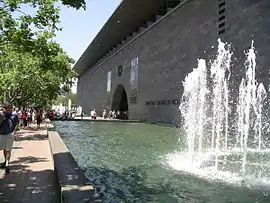
 Queensland Performing Arts Complex. South Brisbane, Queensland. Completed 1985
Queensland Performing Arts Complex. South Brisbane, Queensland. Completed 1985 AAPT Centre (formerly QANTAS). Sydney. Completed 1982
AAPT Centre (formerly QANTAS). Sydney. Completed 1982 Law Courts. Brisbane. Completed 1976-77
Law Courts. Brisbane. Completed 1976-77 10 Murray Street. Hobart. Completed 1969
10 Murray Street. Hobart. Completed 1969.JPG.webp) East Perth Terminal. Completed 1976.
East Perth Terminal. Completed 1976. Perth Concert Hall. Completed 1973.
Perth Concert Hall. Completed 1973.
Structuralist
 Sydney Opera House is often difficult to classify. Completed 1973.
Sydney Opera House is often difficult to classify. Completed 1973. The Australian Academy of Science building, named the "Shine Dome", Canberra, designed by Roy Grounds, completed 1959
The Australian Academy of Science building, named the "Shine Dome", Canberra, designed by Roy Grounds, completed 1959 Sidney Myer Music Bowl. Melbourne. Completed 1959. One of the earliest examples of a tensile structure
Sidney Myer Music Bowl. Melbourne. Completed 1959. One of the earliest examples of a tensile structure.jpg.webp) Lexus Centre (former Olympic Pool). Melbourne. Completed 1956.
Lexus Centre (former Olympic Pool). Melbourne. Completed 1956. Brisbane Convention & Exhibition Centre. Completed 1995. Complex load bearing hyperbolic paraboloid roof design, a precursor to 21st Century structuralism.
Brisbane Convention & Exhibition Centre. Completed 1995. Complex load bearing hyperbolic paraboloid roof design, a precursor to 21st Century structuralism.
Late Modern
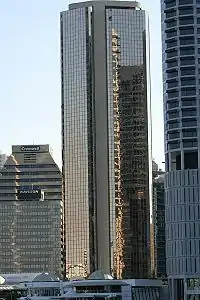
 200 Queen Street. Melbourne. Completed in 1983. Curved mirror glass skyscraper.
200 Queen Street. Melbourne. Completed in 1983. Curved mirror glass skyscraper. Rialto Towers, Melbourne; completed 1986. Australia's best example of a mirror glass corporate skyscraper
Rialto Towers, Melbourne; completed 1986. Australia's best example of a mirror glass corporate skyscraper Waterfront Place, Brisbane. Completed 1989.
Waterfront Place, Brisbane. Completed 1989. Governor Phillip Tower, Sydney. Completed 1994.
Governor Phillip Tower, Sydney. Completed 1994.
 Deutsche Bank Place, Sydney. Completed in 2005, a more recent example of the late modern style
Deutsche Bank Place, Sydney. Completed in 2005, a more recent example of the late modern style
Post Modern
A subset of postmodernism is mock-historicism tries to imitate historic styles using modern materials to the point where it is difficult to tell them apart from historic buildings. The most imitated styles are those that are easiest to clone (including the Georgian style).
 Paddy's Markets redevelopment (completed 1976). Haymarket, New South Wales. Tower is reflective of the building style
Paddy's Markets redevelopment (completed 1976). Haymarket, New South Wales. Tower is reflective of the building style The Jam Factory redevelopment (completed 1979). Chapel Street, South Yarra, Victoria. Completed in 1979. Feature mock historical elements juxtaposted with old factory
The Jam Factory redevelopment (completed 1979). Chapel Street, South Yarra, Victoria. Completed in 1979. Feature mock historical elements juxtaposted with old factory Former Australian Stock Exchange (completed 1990). Collins Street, Melbourne. Features a classical inspired podium base and Georgian inspired pyramid roof.
Former Australian Stock Exchange (completed 1990). Collins Street, Melbourne. Features a classical inspired podium base and Georgian inspired pyramid roof.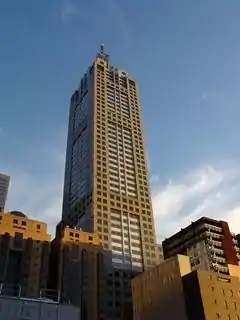 120 Collins Street (completed 1991). Collins Street, Melbourne. Evocative of an interwarNorth American skyscraper.
120 Collins Street (completed 1991). Collins Street, Melbourne. Evocative of an interwarNorth American skyscraper. Chifley Tower (completed 1992). Sydney. Inspired by interwar North American skyscraper
Chifley Tower (completed 1992). Sydney. Inspired by interwar North American skyscraper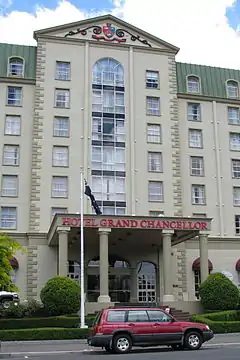 Hotel Grand Chancellor (completed 1993). Launceston, Tasmania. Mock historic composition of Georgian and Second Empire styles.
Hotel Grand Chancellor (completed 1993). Launceston, Tasmania. Mock historic composition of Georgian and Second Empire styles. RMIT Building 8 (completed 1993). Swanston Street, Melbourne. Uses novel decorative elements and references to pop-culture.
RMIT Building 8 (completed 1993). Swanston Street, Melbourne. Uses novel decorative elements and references to pop-culture. Boundary Street retail buildings (completed 1999). West End, Queensland. A cartoonish take on Victorian Mannerism.
Boundary Street retail buildings (completed 1999). West End, Queensland. A cartoonish take on Victorian Mannerism. Westin Hotel (completed 2000). Collins Street, Melbourne. Evocative of the Second Empire.
Westin Hotel (completed 2000). Collins Street, Melbourne. Evocative of the Second Empire. Apartments (completed 2001). Port Melbourne, Victoria evocative of the Second Empire.
Apartments (completed 2001). Port Melbourne, Victoria evocative of the Second Empire.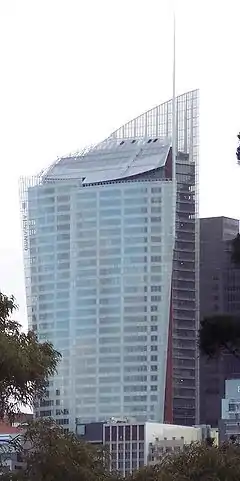 Aurora Place, Sydney. Completed 2000
Aurora Place, Sydney. Completed 2000HSBC_building_George_Street_Sydney.jpg.webp) HSBC Building, George Street, Sydney. Completed 1987
HSBC Building, George Street, Sydney. Completed 1987
Deconstructivist
Notable examples include Green Building RMIT; Deakin University main building; Australian Centre for Contemporary Art; Gottlieb House (Melbourne)
 Storey Hall (The Green Building). RMIT. Swanston Street, Melbourne. Completed 1994. One of the earliest examples of Deconstructivist design in Australia.
Storey Hall (The Green Building). RMIT. Swanston Street, Melbourne. Completed 1994. One of the earliest examples of Deconstructivist design in Australia. 450 Swan Street. Completed 1995. Deconstructivist form integrates an old bank with new offices.
450 Swan Street. Completed 1995. Deconstructivist form integrates an old bank with new offices.
Immigrant's Nostalgic
St_Spyridons_Church_Kingsford-1.jpg.webp) St Spyridon Greek Orthodox Church, Kingsford, New South Wales. Completed in 1975
St Spyridon Greek Orthodox Church, Kingsford, New South Wales. Completed in 1975 Auburn Gallipoli Mosque, Auburn, New South Wales. Completed in 1999
Auburn Gallipoli Mosque, Auburn, New South Wales. Completed in 1999
21st-century architecture
Several new and continued 20th-century styles, all prefaced with "21st-century" - Deconstructivist, Post modern, Structuralist, Sustainable, Modern
Deconstructivist
Notable examples include Fed Square; Shrine of Remembrance crypt; Sofo House (Melbourne) Swan Bells (Perth)
 Swan Bells. Perth. Completed in 2000.
Swan Bells. Perth. Completed in 2000. Federation Square. Melbourne. Completed 2002.
Federation Square. Melbourne. Completed 2002. Australian Centre for Contemporary Art. Southbank, Victoria. Completed 2002
Australian Centre for Contemporary Art. Southbank, Victoria. Completed 2002
Post Modern
 National Museum of Australia. Completed 2001.
National Museum of Australia. Completed 2001. Port 1010 building at the Digital Harbour precinct, Melbourne Docklands. Completed 2008.
Port 1010 building at the Digital Harbour precinct, Melbourne Docklands. Completed 2008.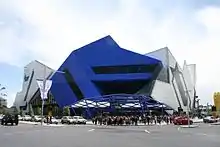 Perth Arena. Completed 2012.
Perth Arena. Completed 2012.
Structuralist
Advanced structuralism facilitated by Computer Aided Design
 Docklands Stadium. Melbourne; completed 2000.
Docklands Stadium. Melbourne; completed 2000. Southern Cross station, Melbourne; completed 2006.
Southern Cross station, Melbourne; completed 2006. Carousel Pavilion, Geelong; completed 2006.
Carousel Pavilion, Geelong; completed 2006..jpg.webp) ANZ Stadium, Sydney Olympic Park. Completed 1999
ANZ Stadium, Sydney Olympic Park. Completed 1999 Olympic Park railway station, Sydney. Competed 1998
Olympic Park railway station, Sydney. Competed 1998
Sustainable
Notable examples in Australia include: 60L (Melbourne); CH2 (Melbourne); K2 Apartments (Windsor, Victoria); Dunc Gray Velodrome (Sydney); Forest EcoCentre (Tasmania); Rozak House (Noonamah, Northern Territory).
 K2 Apartments. Windsor, Victoria. Completed 2006. Highly visible solar panels, prominent natural ventilators and use of natural materials.
K2 Apartments. Windsor, Victoria. Completed 2006. Highly visible solar panels, prominent natural ventilators and use of natural materials. Council House 2. Little Collins Street, Melbourne. Completed 2006. World's first 6 star green rating building features louvered facade, natural and recycled materials, solar panels and thermal mass cooling.
Council House 2. Little Collins Street, Melbourne. Completed 2006. World's first 6 star green rating building features louvered facade, natural and recycled materials, solar panels and thermal mass cooling. Dunc Gray Veledrome. Sydney, New South Wales
Dunc Gray Veledrome. Sydney, New South Wales
Green building
Modern
 Victoria Point, Melbourne Docklands; completed 2005.
Victoria Point, Melbourne Docklands; completed 2005. Freshwater Place, Southbank, Victoria; completed 2006.
Freshwater Place, Southbank, Victoria; completed 2006. Eureka Tower, Southbank, Victoria; completed 2006.
Eureka Tower, Southbank, Victoria; completed 2006. Brisbane Square. Brisbane; completed 2006.
Brisbane Square. Brisbane; completed 2006. Queensland Gallery of Modern Art. Brisbane; completed 2008.
Queensland Gallery of Modern Art. Brisbane; completed 2008..JPG.webp) Brookfield Place, Perth, completed 2012.
Brookfield Place, Perth, completed 2012..jpg.webp)
 200 George Street, Sydney, 2016
200 George Street, Sydney, 2016 World Square, Sydney. 2005
World Square, Sydney. 2005 International Convention Centre Sydney. Completed 2017
International Convention Centre Sydney. Completed 2017
References
- Apperly, Richard; Irving, Robert; Reynolds, Peter (1989). A pictorial guide to identifying Australian architecture (Paperback, 1994 ed.). Sydney, Australia: HarperCollins. ISBN 978-0-207-18562-5.
- "North Sydney Post Office". New South Wales State Heritage Register. Office of Environment and Heritage. H01417. Retrieved 2 June 2018.
- "General Post Office". New South Wales State Heritage Register. Office of Environment and Heritage. H00763. Retrieved 13 October 2018.
- Thalis, Philip; Cantril, Peter John (2013). Public Sydney: Drawing the City. Sydney, Australia: Historic Houses Trust and Content, Faculty of Built Environment, University of New South Wales, Australia. pp. 112–117. ISBN 9781876991425.
- "Goulburn Court House and Residence". New South Wales State Heritage Register. Office of Environment and Heritage. Retrieved 17 November 2017.
- "Paddington Town Hall". New South Wales State Heritage Register. Office of Environment and Heritage. H00561. Retrieved 13 October 2018.
- "Gresham Hotel". New South Wales State Heritage Register. Office of Environment and Heritage. H00291. Retrieved 13 October 2018.
- "Sydney Trades Hall". New South Wales State Heritage Register. Office of Environment and Heritage. H00322. Retrieved 13 October 2018.
- "Ballarat Railway Complex". Victorian Heritage Database. Heritage Council of Victoria. Retrieved 11 October 2019.
- "Brisbane Customs House (former) (entry 600156)". Queensland Heritage Register. Queensland Heritage Council. Retrieved 1 August 2014.
- "Fitzroy Town Hall". Victorian Heritage Database. Heritage Council of Victoria. Retrieved 14 October 2008.
- Hutchinson, David (1987). Fremantle Town Hall, 1887-1987. City of Fremantle. ISBN 0731602005.
- "Architects of South Australia - Architect Details - Frost, Thomas". Architects of South Australia. Architecture Museum, University of South Australia. Retrieved 18 December 2016.
- "{{{2}}}". New South Wales Heritage Database. Office of Environment and Heritage. Retrieved 18 September 2016.
- Cummins, Audrey (25 September 2011). "St Andrew's Manly". The Sydney Organ Journal. Organ Historical Trust of Australia. 29 (3, Winter 1998).
- "Lands Department Building". New South Wales State Heritage Register. Office of Environment and Heritage. Retrieved 29 December 2016.
- "Bank of NSW". New South Wales State Heritage Register. Office of Environment and Heritage. H00080. Retrieved 13 October 2018.
- "Great Synagogue". New South Wales State Heritage Register. Office of Environment and Heritage. H01710. Retrieved 14 October 2018.
- "Bricks & Brass: Edwardian Style". Bricksandbrass.co.uk. Retrieved 2016-10-25.
- "Department of Education Building". NSW State Heritage Register. Office of Environment & Heritage, Government of New South Wales. 9 February 2015. Retrieved 30 December 2016.
- "Central Railway Station and Sydney Terminal Group". New South Wales State Heritage Register. Office of Environment and Heritage. Retrieved 18 October 2017.
- "Sydney Architecture Images- Newtown Post Office". sydneyarchitecture.com. Retrieved 2019-10-13.
- "Sydney Architecture Images- Newtown Post Office". sydneyarchitecture.com. Retrieved 2019-10-13.
- "Sydney Architecture Images- Newtown Post Office". sydneyarchitecture.com. Retrieved 2019-10-13.
- "Sydney Architecture Images- Newtown Post Office". sydneyarchitecture.com. Retrieved 2019-10-13.
- "Sydney Architecture Images- Newtown Post Office". sydneyarchitecture.com. Retrieved 2019-10-13.
- "Corn Exchange". New South Wales State Heritage Register. Office of Environment and Heritage. H01619. Retrieved 14 October 2018.
- Ulrike Laule, Rolf Toman, Achim Bednorz - Architecture of the Middle Ages - Background to the Gothic Revival style.
- George Wilkie - Building Your Own Home - Section on Architectural Styles
- https://www.webcitation.org/query?url=http://www.geocities.com/asiedydd/styles.htm&date=2009-10-25+12:44:01
- http://www.canberrahouse.com.au/organic.html
- http://www.wiki.jeremymacpherson.net/index.php?title=Research_Guide_1:_Buildings#Key_Architectural_Styles
- sydneyarchitecture.com Chronology of Styles in Australian Architecture- https://web.archive.org/web/20140908110249/http://sydneyarchitecture.com/STYLES/search-style.htm
Central_building_Broadway_Sydney-1.jpg.webp)